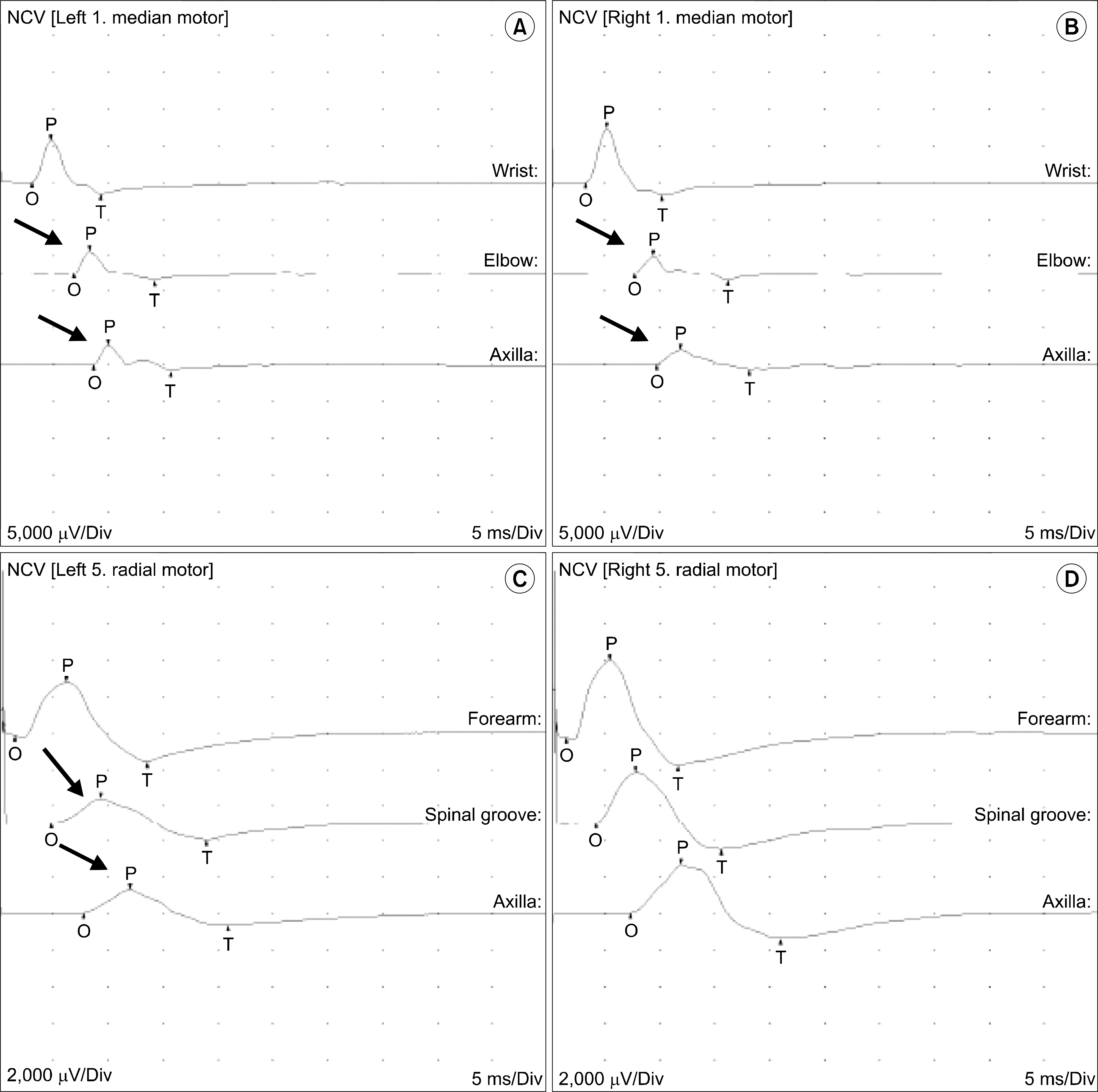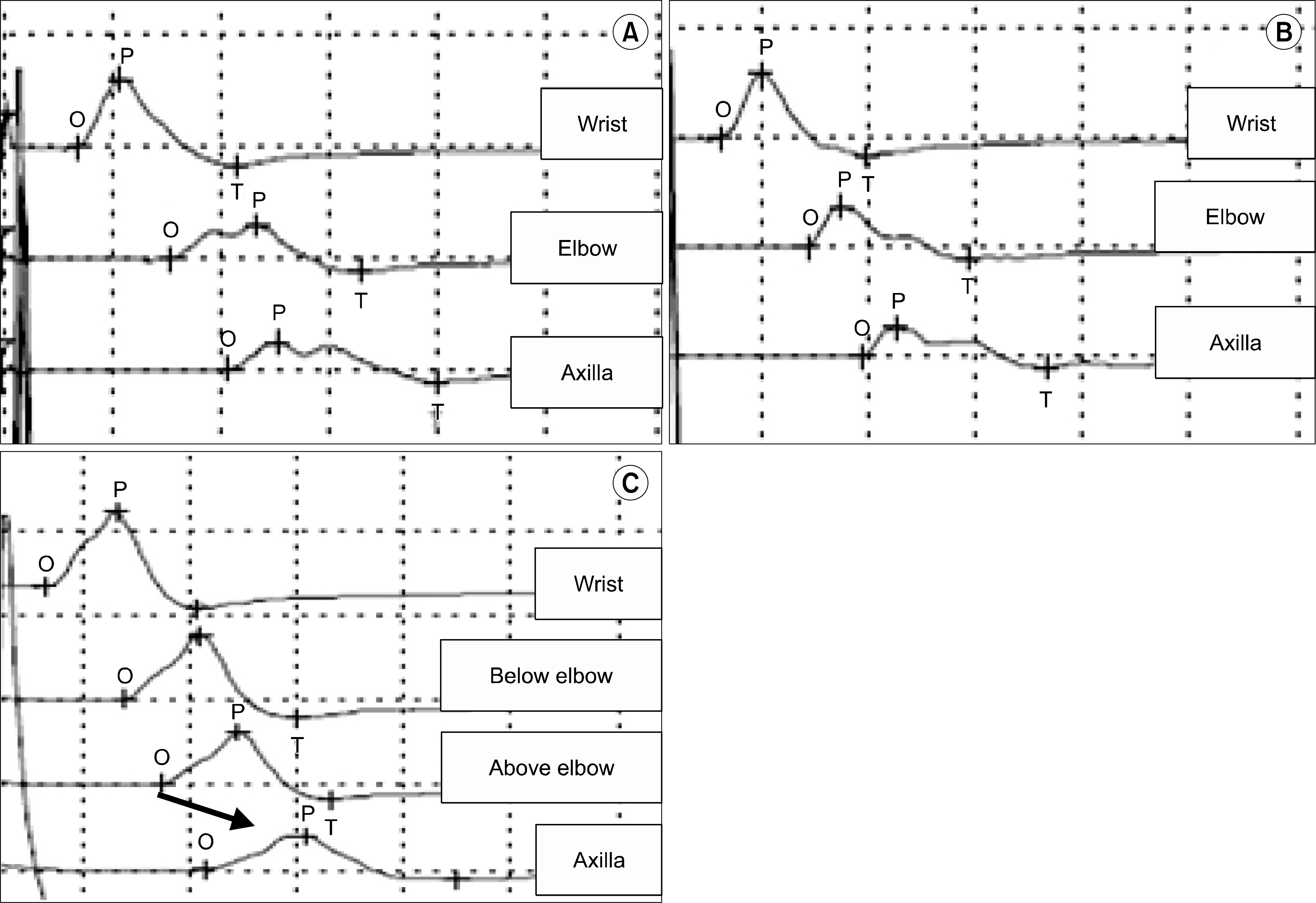Abstract
Tumor necrosis factor (TNF) inhibitors are increasingly used in treatment of rheumatoid arthritis (RA), ankylosing spondylitis, psoriatic arthritis, and inflammatory bowel diseases including Crohn's disease and ulcerative colitis. Rarely, anti-TNF therapy is associated with neurological complications, including both central and peripheral nervous system disorders. To the best of our knowledge, only one case of infliximab-associated multifocal motor neuropathy with conduction block in a patient with spondyloarthropathy has been reported to date in Korea. Here, we report on the case of a 58-year-old Korean woman affected by RA who developed multifocal motor neuropathy after infliximab treatment.
REFERENCES
1. Choy EH, Panayi GS. Cytokine pathways and joint inflammation in rheumatoid arthritis. N Engl J Med. 2001; 344:907–16.

2. Stübgen JP. Tumor necrosis factor-alpha antagonists and neuropathy. Muscle Nerve. 2008; 37:281–92.
3. Lin J, Ziring D, Desai S, Kim S, Wong M, Korin Y, et al. TNFalpha blockade in human diseases: an overview of efficacy and safety. Clin Immunol. 2008; 126:13–30.
4. Kaltsonoudis E, Voulgari PV, Konitsiotis S, Drosos AA. Demyelination and other neurological adverse events after anti-TNF therapy. Autoimmun Rev. 2014; 13:54–8.

5. Vlam L, van der Pol WL, Cats EA, Straver DC, Piepers S, Franssen H, et al. Multifocal motor neuropathy: diagnosis, pathogenesis and treatment strategies. Nat Rev Neurol. 2011; 8:48–58.

6. Kim RB, Kang DH, Lee SY, Han JS, Lim SK, Song SH, et al. Multifocal motor neuropathy with conduction blocks during TNF-alpha antagonist therapy in a patient with spondyloarthropathy. J Rheum Dis. 2013; 20:177–80.

7. Magnano MD, Robinson WH, Genovese MC. Demyelination and inhibition of tumor necrosis factor (TNF). Clin Exp Rheumatol. 2004; 22(5 Suppl 35):S134–40.
8. Solomon AJ, Spain RI, Kruer MC, Bourdette D. Inflammatory neurological disease in patients treated with tumor necrosis factor alpha inhibitors. Mult Scler. 2011; 17:1472–87.

9. Singer OC, Otto B, Steinmetz H, Ziemann U. Acute neuropathy with multiple conduction blocks after TNFalpha monoclonal antibody therapy. Neurology. 2004; 63:1754.
10. Cocito D, Bergamasco B, Tavella A, Poglio F, Paolasso I, Costa P, et al. Multifocal motor neuropathy during treatment with infliximab. J Peripher Nerv Syst. 2005; 10:386–7.

11. Rodriguez-Escalera C, Belzunegui J, Lopez-Dominguez L, Gonzalez C, Figueroa M. Multifocal motor neuropathy with conduction block in a patient with rheumatoid arthritis on infliximab therapy. Rheumatology (Oxford). 2005; 44:132–3.

12. Tektonidou MG, Serelis J, Skopouli FN. Peripheral neuropathy in two patients with rheumatoid arthritis receiving infliximab treatment. Clin Rheumatol. 2007; 26:258–60.

13. Fardet L, Dupuy A, Kerob D, Levy A, Allez M, Begon E, et al. Infliximab for severe hidradenitis suppurativa: transient clinical efficacy in 7 consecutive patients. J Am Acad Dermatol. 2007; 56:624–8.

14. Lozeron P, Denier C, Lacroix C, Adams D. Long-term course of demyelinating neuropathies occurring during tumor necrosis factor-alpha-blocker therapy. Arch Neurol. 2009; 66:490–7.

15. Paolazzi G, Peccatori S, Cavatorta FP, Morini A. A case of spontaneously recovering multifocal motor neuropathy with conduction blocks (MMNCB) during anti-TNF alpha therapy for ankylosing spondylitis. Clin Rheumatol. 2009; 28:993–5.

16. Carrilho PE, Araújo AC, Alves O, Kotze PG. Motor neuropathy with multiple conduction blocks associated with TNF-alpha antagonist. Arq Neuropsiquiatr. 2010; 68:452–4.

17. Theibich A, Dreyer L, Magyari M, Locht H. Demyelinizing neurological disease after treatment with tumor necrosis factor alpha-inhibiting agents in a rheumatological outpatient clinic: description of six cases. Clin Rheumatol. 2014; 33:719–23.

18. Fernández-Menéndez S, González Nafría N, Redondo-Robles L, Sierra-Ausín M, García-Santiago R, Saponaro-González A. Multifocal-motor-neuropathy-like disease associated with Infliximab treatment in a patient with Crohn's disease. J Neurol Sci. 2015; 349:246–8.

19. Barber CE, Lee P, Steinhart AH, Lazarou J. Multifocal motor neuropathy with conduction block following treatment with infliximab. J Rheumatol. 2010; 37:1778–80.

20. Miller FW, Pollard KM, Parks CG, Germolec DR, Leung PS, Selmi C, et al. Criteria for environmentally associated autoimmune diseases. J Autoimmun. 2012; 39:253–8.

21. Tristano AG. Neurological adverse events associated with anti-tumor necrosis factor α treatment. J Neurol. 2010; 257:1421–31.
Figure 1.
Motor nerve conduction studies of bilateral median (A, B) and radial (C, D) nerves during the first examination of the study patient, performed several months after symptom onset. It is notable that in panels A and B, the muscle responses after stimulation at the axilla and elbow (arrows) were reduced in amplitude and area by 50% compared with those after a more distal stimulation at the wrist. In panel C, muscle responses after stimulation at the spinal groove and axilla (arrows) showed a 50% reduction in amplitude and area as compared with those after more distal stimulation at the forearm. These findings are in accordance with the definition of a focal motor conduction block across that nerve segment. On the other hand, in panel D, it was evident that the muscle responses after stimulation at the spinal groove and axilla were less than 50% reduced in amplitue and area as compared with those after more distal stimulation at the forearm. NCV: nerve conduction velocity, O: onset, P: peak, T: threshold.

Figure 2.
Three months after stopping infliximab, the conduction blocks of the bilateral median nerves (A, B) showed no interval change compared with the previous motor nerve conduction studies. In panel C, muscle responses after stimulation at the axilla (arrow) were 50% reduced in amplitude and area as compared with those after more distal stimulation at the wrist. O: onset, P: peak, T: threshold.





 PDF
PDF ePub
ePub Citation
Citation Print
Print


 XML Download
XML Download